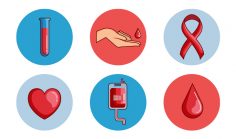View a HIV Fast Facts Slideshow
HIV (Human Immunodeficiency Virus) is the virus responsible for AIDS (acquired immune deficiency syndrome). Once infected by HIV, the body can never rid itself completely of the virus. Though HIV is a precursor to AIDS, HIV infection does not guarantee the development of AIDS. The HIV virus can lay dormant in the body for years before becoming active, or it may never become active at all. New technologies and treatments have allowed scientists to better control the activity of HIV, making it possible to delay or prevent the development of AIDS.
There are three stages of HIV infection:
STAGE 1: Acute infection. This stage occurs 2-4 weeks after the initial exposure to the virus and is characterized by severe flu-like symptoms. During this time, the virus rapidly reproduces itself within CD4 cells, which are a subtype of white blood cells, and then destroys them, causing blood levels of HIV viruses to rapidly rise and CD4 cells to rapidly fall. High blood levels of the HIV virus make the infected individual highly contagious (though the disease can still only be contracted through contact with infected fluids.) The flu-like symptoms experienced during this stage are referred to as “acute retroviral syndrome” and may include:
- Fever
- Swollen glands
- Muscle aches
- Headache
- Fatigue
- Sore throat
STAGE 2: Clinical Latency. During this stage, HIV reproduction slows dramatically. Individuals are still infectious, though their symptoms may decrease or go away entirely. The duration of the clinical latency period varies from patient to patient. Antiretroviral therapy is a form of treatment developed in the late 1980s that has since been found to be extremely effective at lengthening the clinical latency period and delaying the onset AIDS, the third and final stage of an HIV infection. Before antiretroviral therapy, HIV infections typically progressed to AIDS within a few years. With antiretroviral treatment, the progression can take decades or may not occur at all.
STAGE 3: AIDS. (Acquired Immune Deficiency Syndrome) is a syndrome, meaning a collection of symptoms, which occurs in the final stage of HIV infection. HIV infection becomes AIDS once the virus has weakened the immune system enough to allow for a serious ‘opportunistic infections’. The list of possible symptoms produced by AIDS related infections is almost infinite, given the wide range of possible infection types.
The following conditions are the most common of these ‘opportunistic infections’:
- Pneumocystis pneumonia (an infection of the lung)
- Kaposi’s sarcoma (a type of skin cancer)
- Cytomegalovirus infection (viral infection typically affecting the eyes)
- Candida (candida albicans infection)
The transition from HIV to AIDS can also be determined by CD4 counts in the blood. A healthy adult CD4 count ranges from 500 cells/mm3 to 1,200 cells/mm3. An HIV patient is said to have AIDS once their CD4 count is below 200.
The CDC estimates that more than 1.1 million people in the Unites States are living with HIV infection, though 1 in 6 do not know it. In 2011, an estimated 49,273 new cases of HIV were diagnosed. In the same year, 32,052 new AIDS diagnoses were made. It is estimated that approximately 35 million people are living with HIV infection around the globe. HIV is spread through contact with infected fluids. This transmission most often occurs sexually, though it may also occur through the use of shared needles, consumption of infected breast milk, in utero from mother to fetus, or any other instance of contact with infected body fluids.













